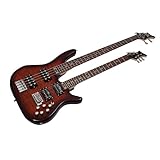
Average Reviews:

(More customer reviews)I play in a trio situation: There is a keyboard-player and a drummer and I play bass and sing most of the time and I play guitar on some of the songs (guitar solos are supposed to excite the audience). When I play guitar, the keyboard-player takes over for bass with his left hand (cool!). Until now, it was a drag switching from bass to guitar in the middle of a song. So I searched the internet for a double-neck bass guitar. And I found this instrument. For a price, I couldn't believe (mine was even cheaper than this one, but as I live in Europe, so I had to pay customs).
I received this instrument via mail a couple of days ago and it is great! I read a review before buying it where somebody complained that it's so heavy, so I put it on my scales immediately. 5 kg = 10 pounds - that's just a little more than the average Gibson Les Paul and even less than the Fender Telecaster Deluxe I had in the early 80s (the one with the humbuckers). It is pretty well manufactured - well, I'll ask my guitar repair guy in a couple of days and he always finds something to complain about. For me as a player, it appears to be well done and it feels good to play. The sound of both the guitar and the bass is certainly not the best I ever heard, but better than average. The audience won't notice the difference to my other instruments. Action is very low (I adore) and every part of the instrument is easy to play. No string buzzing anywhere. 24 frets on both necks - great! The tremolo works very well and I haven't managed to detune the guitar with it so far.
There are a few drawbacks though: If you want to play the bass with your thumb behind the neck ('comme-il-faut'), then there is no way going lower than third fret, because the machine heads of the guitar neck are in the way. On frets 2, 1 and in open position, you have to play the bass "from the fist". If the angle between the two necks was just this tiny little bit bigger, it would work. No problem for me though.
Both necks send their sound to one socket. Hmmm. The guitar doesn't sound too good over the bass amp and the bass has the power to blast the speaker of my guitar amp. 'Been there, done that ...' - I am thinking of building a Roland GK-3 into the guitar part and using the VG-99 (guitar modeling and guitar synthesizer) to turn this instrument into the Ultimate-I-Can-Play-Any-Sound-Instrument and solve this problem. My budget is a bit reluctant to the idea.
I wish there was a 'manual' or even just a little sheet explaining the function of those knobs. Spent some time, but I'm still not sure about all the functions.
So far I tested the instrument in the following situations, trying to switch quickly from bass to guitar and vice versa:
Blues (great!), Blues Rock (cool), Metal (well, some Lemmy on the bass part doesn't hurt, but I prefer bass without distortion - that's a bit of 'technical stress': switching to the other neck, putting away the pick, stepping on the effect-pedal. I'll manage!), Jazz (Bebop to Fusion - the bass sound will need some adjusting for Walking-Bass), Funk (wow - slapping is great with this bass! And the guitar can produce some very funky sounds), Country (cool). It took me a few moments to get adjusted, but I soon felt very comfortable in all these situations and I liked the sound. If you play both guitar and bass, it's not as if you had to learn a new instrument.
The reactions of my friends show me that it's a real eye-catcher! Very good for promo. Ask Jimmy Page about it (with his 12-String, 6-String Double Neck Guitar).
I love this instrument and I'm looking forward to my first gig with it. I won't play it all the time though - only where I need to switch.
Click Here to see more reviews about: 4 String Bass & 6 String Double Neck Guitar w/ Case
Click here for more information about 4 String Bass & 6 String Double Neck Guitar w/ Case

0 comments:
Post a Comment